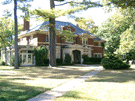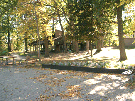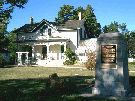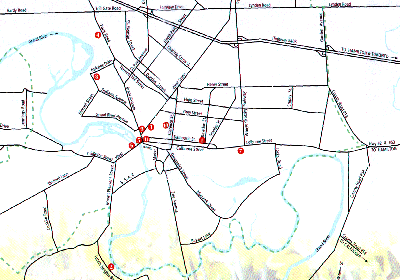
 |
 |
 |

|
 |
 |
 |

|
 |
 |
 |
| Click
on the product menu above to find more info about products and services
we provide. Use the showcase menu to the right to see a selection of our
example virtual tours and featured virtual tours and listings.. |

|
 |
|
 |
Brantford - Parks & Gardens
| Brantford's beautiful award-winning
parks and gardens are internationally known. Give yourself an opportunity
to discover and experience the floral and historic splendor of our Victorian
city. |
|

|
|
| 1
ALEXANDRA PARK |
| Alexandra Park is one of
the oldest parks in the city. It was originally intended as a market square
for the residents of the community. In 1914, the renowned landscape architect,
Dunnington-Grub, proposed the development of a very formal park complete
with pathways, a central bandstand, and flower beds. Only a portion of
the originally proposed work was ever completed. The cannon located along
Dalhousie Street is Russian. It was confiscated during the Crimean War,
and given as a gift to the City of Brantford by the British 7th Royal Fusiliers
during their stay in the city around 1866. |
| 2
BELL HOMESTEAD |
| Alexander Melville Bell
purchased this property in 1870 for the grand sum of $2,600. It was here
that his son, Alexander Graham Bell, invented the telephone. The grounds
around the Homestead are gradually being returned to a landscape that is
more reminiscent of the late 1800's. A kitchen garden, flowering perennials
and a less pristine lawn are now key interpretive elements of the site.
The Tea House on the site is open year-round. |
| 3
BELL MEMORIAL |
| The Bell Memorial sculpturally
represents man's ability to transmit sound through space. The two bronze
figures flanking the main panel represent humanity. One figure is portrayed
in the act of sending, the other receiving, messages over the telephone.
The park itself is laid out in a grand manner, as recommended in Dunnington-Grub's
1914 landscape plan. Today, the park still reflects a very formal layout
and its pathway is lined by beds of flowering annuals. |
| 4
GLENHYRST GARDENS |
| This beautiful property
was the former residence of the Cockshutt's - one of Brantford's most influential
families. Bequeathed to the City in 1956, the estate is now home to the
Glenhyrst Art Gallery of Brant, and features art exhibits in the main house
gallery, workshops in the old coach house, and a gardener's cottage now
used as space for rent by artists. The upper gardens are maintained as
one of Brantford's finest horticultural parks - displaying spectacular
annual plantings, specimen trees, and shrubs. It provides a setting for
various contemporary sculptures and earthworks, as well as more traditional
works of "garden art". The lower gardens are gradually being restored to
a more natural state with wildflower plantings, organic garden plots and
Carolinian forest species. Glenhyrst
Gardens & Glenhyrst Art Gallery of Brant Virtual Tour |
| 5
JUBILEE TERRACE |
| Opened in 1897 as part of
Brantford's "Queen Victoria Diamond Jubilee" celebrations, Jubilee Terrace
has always provided scenic views of the Lorne Bridge and the Grand River.
The park fronts on to the Dufferin Rifles Armoury - built in 1893 and named
after the Earl of Dufferin, Governor General. The site is also home to
Brantford's first war memorial, erected in 1903 in honour of three Brantford
men who died in Boer War. |
| 6
LORNE PARK |
| Brantford's premier horticultural
park was reclaimed from the Grand River and has become the heart of the
community's parks inventory. In 1920, the park was known as "Pickwick Park"
and was used by avid miniature golf enthusiasts. Lorne Park contains the
largest public rose garden in the community. An abundance of annual plantings
create a perfect backdrop for wedding photos throughout the spring and
summer.
|
| 7
MOHAWK PARK |
| The park was officially
opened on May 24, 1895, at the terminus of the Brantford Street Railway.
The site was formerly part of Lovejoy Estate and a popular site for swimming,
canoeing, cricket matches and bicycling. The oak forest is by far the most
significant natural component of the site. After years of heavy usage,
the oaks have declined. In an attempt to restore the forest, the westerly
section of the park has been allowed to regenerate and the growth of young
oaks can now be seen. Take
a Virtual Tour |
| 8
PRESTON PARK |
| Preston Park is one of only
a few horticultural parks located within a residential neighbourhood. Originally,
the lower sunken area was a goldfish pond. Laid out in a formal Beaux Arts
style, the park features specimen trees, shrubs, and colourful annual plantings. |
| 9
TOM THUMB |
| Although no formal record
can be found, it is assumed that the park draws its name from its diminutive
size. The park contains large annual beds in both sun and shade and a selection
of specimen trees. The I.O.D.E. monument honours the men and women who
served during World War II. |
| 10
VICTORIA PARK |
| The original survey of the
park was formally established by architect, John Turner, upon completion
of the adjacent Courthouse building. In 1866, the magnificent bronze monument
to Iroquois leader, Captain Joseph Brant, was unveiled as the central feature
of the square, and by the early 1900's, the grounds displayed a formal
layout paths, hedges and specimen trees. Today, panel beds mark the corners
of the "Union Jack" square and colourful annuals highlight the historic
statue of Joseph Brant. |
| 11
WAR MEMORIAL |
| Originally dedicated in
1933, the Cenotaph or War Memorial recognizes all those who served and
lost their lives in World War I and II and the Korean War. The seven bronze
figures represent the various branches of the armed forces. This monument
is unique, in that it portrays the role played by women during World War
II. The park is bound by clipped hedging and once was used for carpet bedding
displays. |

|
 |
 
|

 |



